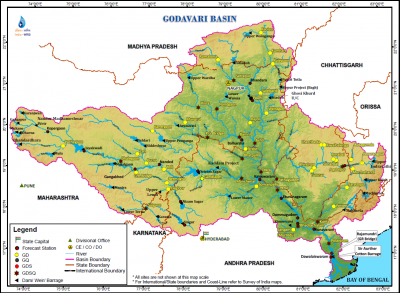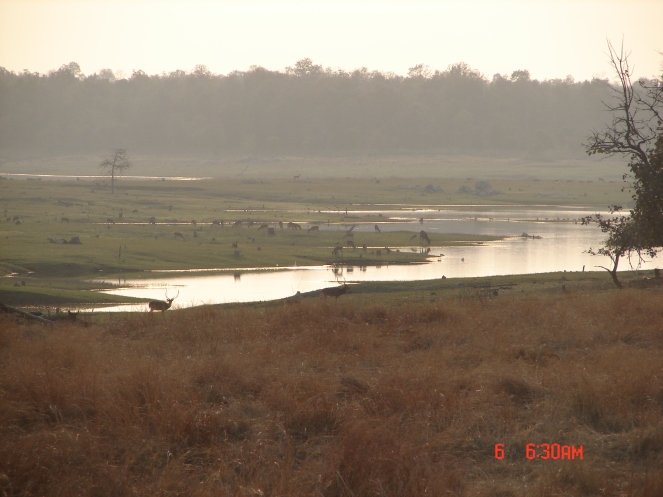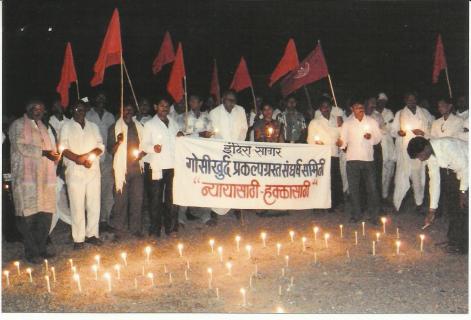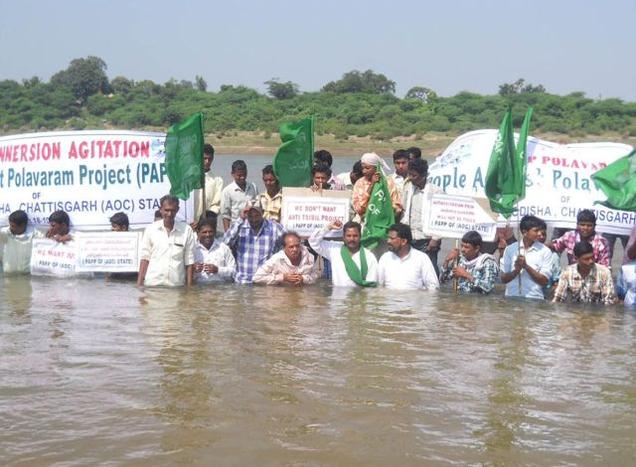Introduction
Godavari, the Dakshin Vahini Ganga, originates at an elevation of 1067 meters in the Brahmagiri Hills of the Western Ghats in Nashik District of Maharashtra and continues its journey over 1465 kms in the south east to meet the Bay of Bengal at Narasapuram in West Godavari district of Andhra Pradesh. Like many Indian rivers, Godavari’s origin is consecrated with a Shiva Temple, the Trimbakeshwar, which is also one of the 12 Jyotirlingas (most of them near a river). And like many other rivers, it has an elaborate myth and a hymn in its honour. The river has a sister, Gautami, right at its origin in Maharashtra and again a distributary called Gautami right where the river falls into the sea in Andhra Pradesh!

The river mainstem, longest in Peninsular India, travels through three states, Maharashtra, Telangana and Andhra Pradesh, while its basin includes Madhya Pradesh, Karnataka, parts of Chattisgarh and Odisha. It traverse through 3 agroclimatic zones, 6 agro ecological zones and supports an astounding array of biodiversity and communities. More than 60 million people call Godavari Basin their home. The basin includes important towns like Nashik, Nagpur, Wardha, Nanded and Chandrapur from Maharashtra and Bhadrachalam, Nizamabad, Mancherial & Ramagundam in Telangana, Rajahmundry & Narsapur in Andhra Pradesh and Seoni & Balaghat in Madhya Pradesh.

The river is considered no less than a sister to Ganga and I remember as a child, elders always referring to Godavari as Ganga. Nashik is important religiously not only as the birth place of this Dakshin Vahini Ganga, where she refused to fall into the Arabian Sea, but also because of the deep association of the city with Ramayana. Nashik was believed to be a part of Dandakaranya where Lord Ram resided for nearly 14 years in Vanavasa. All along the river in places like Tapovan, one can find glimpses of this ancient myth worshipped today. On the banks of Godavari in Nashik also stands the KalaRam Mandir where, in 1930, Babasaheb Ambedkar launched the KalaRam Mandir Entry Satyagraha, storming the temple which was thus far restricted for the depressed classes. Indeed, Godavari has borne witness to several remarkable happenings at her origin itself.
In her middle reaches in Nanded, Takth Sri Hazur Sahib graces the banks of the river where Guru Gobind Singh breathed his last. The place is one of the five holy places in Sikkhism. In Telangana and Andhra too the banks have numerous mosques, temples and ghats of historical significance like Kotilingala in Karimnagar, Telangana, at the confluence of Peddavagu and Godavari. This was the first capital of the Satavahanas circa 230 BC. Most of the important towns in Satavahana era are along the Godavari. Sadly today the Koti Lingala is facing threat of submergence from Sripada Yellampalli Irrigation project. At Dhawaleswaram the river divides into two branches, the Gautami and Vasishta. Between the two lies the Godavari Central Delta. The two arms split into branches as they approach the sea dividing the Central Delta into a number of islands.
Anne Feldhaus sums up the historical legacy of many cultures and religions of this upper Godavari Valley and Marathwada eloquently. She says: “This is the area that Cakradhar, the founder of the Mahanubhav sect (circa 12-13th Century), referred to as the “Ganga valley” that is, the (upper) valley of the Godavari, the northernmost of the great rivers that flow from northwest to southeast across the Deccan Plateau. In Cakradhar’s time, what is now Marathwada was the core of the Yadava kingdom, with its capital at Devgiri (subsequently called Daulatabad). Paithan, the capital of the much earlier kingdom of the Satavahanas (first century B.C.E. to third century C.E.) is also found in Marathwada, on the Godavari river, as is Nanded, the site of the grave of the seventeenth-century Sikh leader Govind Singh. The Mughal emperor Aurangzeb’s city, Aurangabad, is now the principal city of Marathwada in Godavari basin, which is also home to the Buddhist (and Jain and Hindu) caves at Ajanta and Ellora (called Verul in Marathi) and to the major Sufi shrines at Khuldabad.” (From: Feldhaus, Anne, in History of Sacred places in India as reflected in traditional literature, Edited by Hans Bakker, 1990)

Basin Characteristics
(Based on WRIS Basin Profile on Godavari)
Godavari Basin accounts for nearly 9.5% of the total geographical area of the country and extends over states of Maharashtra (48.7%), Andhra Pradesh & Telangana (23.7%), Chhattisgarh (12.4%) and Odisha (5.7%) in addition to smaller parts in Madhya Pradesh (7.8%) and Karnataka (1.4%)

| Table-I: Important Tributaries of Godavari | ||
| Sr. No. | Name of Tributary | Length |
| 1 | Godavari | 1419 |
| 2 | Purna | 382.16 |
| 3 | Penganga | 634.36 |
| 4 | Wardha | 538 |
| 5 | Wainganga | 635.40 |
| 6 | Pranhita | 111.0 |
| 7 | Indravati | 558.96 |
| 8 | Sabari | 179.99 |
| 9 | Kolab | 240.05 |
| 10 | Pravara | 198.79 |
| 11 | Manjara | 198.79 |
Around 32% of Godavari basin area lies in the elevation zone of 500-750 m. Average annual rainfall (1971-2005) is 1096.92 mm. While the high rainfall zone of Western Ghats the annual rainfall varies from 1000 to 3000 mm region on the east of Western Ghats falls in the rain shadow area which experiences less than 600 mm rainfall. About 60% of the basin is covered with agricultural land. Forest area is about 29.78% and water bodies occupy 2.06% of the total basin area.
Sub Basins: The Godavari basin is divided into 8 sub-basins. Principal tributaries are listed in Table-I above.
Geography of the basin: The basin is bounded by the Mahadeo Hills of the Satpura Range in the north, the Western Ghats in the west, Eastern Ghats of the Dandakaranya region of Odisha, Chattisgarh and Andhra in the east. The onterior part of the basin lies in Maharashtra and in a snese the Godavari basin bisects the plateau of Maharasthra.The basin also covers the Vidarbha Plain and the forest covered Wainganga valley. The area is rich in natural vegetation that covers the rugged hilly land.
Wildlife sanctuaries/ Protected areas/ National Parks in the basin: Godavari basin supports significant forest are in the Central India much of this is in the belt of eastern Maharashtra, Chhattisgarh and Telangana states. Wainganga, one of the most important tributary of the Godavari is the stage of Kipling’s Jungle Book. Wainganga basin is home to three tiger reserves viz. Tadoba and Pench National Park in Maharashtra and Indravati National Park in Chhattisgarh. Table-II lists these areas.

| Table-II: Wildlife sanctuaries/ Protected areas/ National Parks in the basin: | |||
| Sr. No. | State | Wildlife sanctuaries/ Protected areas/ National Parks | District |
| 1. | Maharashtra | Tadoba National Park (Tiger Reserve) | Chandrapur |
| Bor Wildlife Sactuary | Wardha | ||
| Navegaon Wildlife Sanctuary | Gondiya | ||
| Nagzira Wildlife Sanctuary | Gondiya | ||
| Pench National Park (Tiger Reserve) | Seoni | ||
| 2 | Chhattisgarh | Bhairamgarh Wildlife Sanctuary | Dantewada |
| Kanger Ghati National Park | Bastar | ||
| Indravati National Park (Tiger Reserve) | Dantewada | ||
| Pamed Wildlife Sanctuary | Dantewada | ||
| 3 | Andhra Pradesh | Coringa Wildlife Sanctuary | East Godavari |
| Papikonda Wildlife Sanctuary | West Godavari | ||
| 4 | Telangana | Kinnerasani Wildlife Sanctuary | Khammam |
| Pocharam Wildlife Santuary | Medak | ||
| Manjira Bird Sanctuary | Nizamabad | ||
| Eturnagaram Wildlife Sanctuary | Warangal | ||
| Kawal Wildlife Sanctuary | Adilabad | ||
| Siwaram Wildlife Sanctuary | Karimnagar | ||
| Pranhita Wildlife Sanctuary | Adilabad | ||
| Siwaram Wildlife Sanctuary | Karimnagar | ||

Fish and Fisheries in the Basin: Godavari Basin is rich in fish species. The estuarine zone itself is habitat for nearly 228 species, some of which are marine. While the upper stretch of the river is nearly completely dependent on reservoir water releases for fisheries the middle zone has species like Carps, Mahseer, and prawns. Delta, in times of floods and monsoon has rich fisheries of prawns, large sized carps, catfishes, Puntius species, etc. According to CIFRI reports (Selvaraj, 2000, River Godavari: Environment and Fishery, CIFRI), dams like Polavaram will affect a number of species like prawns, which would get severely restricted, Hilsa and carps. The impacts of Polavaram on the lives of thousands of migrating fisherfolk has been documented. Hilsa, or the Pulasa, as it is called in the local language is famed in the estuary.
Major Challenges faced by the Godavari and it inhabitants
1. Dams, Barrages and Anicuts
Dams are a primary challenge faced by a river due to the profound ways in which they affect the hydrology, ecology, sociology, continuum of the river.
According to MoWR (Ministry of Water Resources), so far nearly 921 Dams, 28 Barrages, 18 Weirs, 1 Anicut, 62 Lifts and 16 Powerhouses have been constructed in the basin for irrigation, diversion or, storage purpose. The basin has 70 Major Irrigation Projects and 216 Minor Irrigation Projects.
One of the oldest barrage in the basin as well as the country is the Dowleshwaram Barrage also known as Arthur Cotton Barrage, situated on the Godavari Delta near Rajamundry, Andhra Pradesh. Godavari barrage has come up by remodeling the Dowleshwarmam barrage and irrigates the Godavari Delta. The barrage does not have a fish lift or a pass and does not releases eflows in the downstream, starving the delta of sediment and water and blocking migration of the fames Pulasa, Hilsa fish.

Other important projects include Sri Ram Sagar Project or the Pochampadu project in Nizamabad, Telnagana and the Jayakwadi Project in Paithan, Maharahstra. Jayakwadi project boasts of the one of the longest dam walls in the country, running more than 10 kms, which has resulted in massive evaporation losses from the reservoir. The project was built displacing 70 villages and is now in the eye of the storm as intra state water disputes heat up in Maharashtra. In the upstream of Jayakawadi are more than 11 large dams in the districts of Nashik and Ahmednagar, which is a cane and grape growing region. Downstream Jayakawadi too are several projects on the Godavari and tributaries in Maharashtra like 11 barrages on Godavari, Vishnupuri, Upper Penganga, etc. The massive GosiKhurd Dam coming up on Wainganga River, one of the biggest tributary of Godavari, is mired is corruption charges. The project will submerge more than 100 villages and is witnessing stiff resistance from the region.

The Nizamsagar multipurpose project is constructed in Nizamabad district in Telengana on Manjira River in 1931. Kaddam Reservoir is constructed on the Kaddam River in Adilabad district of Andhra Pradesh. The dam broke in a year after construction in 1958, by 4.6 cms water flowing over the crest.[1] Upper Indravati multipurpose project on the Indravati in Odisha diverts waters of the Indravati into the Mahanadi for power generation. Upper Kolab dam was completed in 1990 on Kolab River, Orissa, it has a live storage capacity of 935 MCM. At FRL, the reservoir water spread covers 114 sq. km. The dam displaced more than 50,000 people in the Koraput district of Odisha, who were already distressed by a number projects in Odisha. Hydro projects in the Sileru river, a tributary of Godavari in Odishna has displaced thousands of tribals till date. Thee projects include Machkund (120 MW), Balimela (510 MW), Upper Sileru (240 MW), Donkarayi (25 MW) and Lower Sileru hydro (460 MW) power project.
According to this disturbing report, about 20,000 people from 6 grampanchayats, predominantly tribal are cut off from the main land for several years, first by the Machkund Hydro electric project and then by Balimela Project. They hire a ferry to get to mainland and in 2010, this ferry was targeted and attacked by the maoists.

Surplus basin or Deficit Basin? Surprisingly. although there is a severe water scarcity in many parts of the basin, leading to increasing conflicts, the National Water Development Agency, responsible for works related to Interlinking of Rivers, classifies Godavari as a Surplus Basin and plans diversions from Godavari into other basins like Krishna and Pennar. Ironically, in Maharashtra, there are projects underway to transfer water from Krishna to Godavari!( Krishna Marathwada Lift Irrigation Project).
The situation only highlights the fallacies of labeling river basins “Surplus” or “Deficit”. Maharashtra is in fact already transferring water from west flowing basins into Godavari, in a very unscientific manner.

2. Upcoming projects and Major Struggles:
The basins is also witnessing massive conflicts over water. Perhaps Godavari is the first basin in the country to witness a long drawn and oft repeated intrastate water conflict between stakeholders upstream of Jayakwadi and those downstream. The conflict does not seem to subside with entrenched positions, proliferation of water intensive crops like sugarcane and lack of open communication and transparency from the administration. Lower Penganga project, which is set to displace more than 20 villages in the fertile belt of Yavatmal is also witnessing a huge protest against the dam project. Gosikhurd project on Wainganga too is witnessing massive struggle not only from the farmers upstream, but also fisherfolk who fish in the rich Wainganga at present. The upcoming Pranahita-Chevella link, a part of the Jalyagnam project in the present Telanagana is likely to see conflicts as Maharashtra appears to be the loser, losing forest lands, protected area and tribals villages for no tangible gains. Already, water sharing conflicts between newly formed Telangana and Andhra Pradesh are on the anvil.


Jalyagnam project, an intricate plan of over 78 dam projects and lift irrigation schemes mostly on Godavari has also been in the eye of the storm for huge corruption charges, massive displacement and contractor-friendly nature, ignoring the deep impacts on the river and its people.
Other planned projects include: Polavaram, a project which can submerge 276 villages in Telangana, Odisha and Madhya Pradesh, displacing nearly 1,50,000 people! The EIA of the project was majorly flawed, the Public Hearing was rigged and there is huge local opposition to the project. Hydel projects like Bhopalpatanam and Ichampalli projects on Indravati River can submerge near nearly 2 lakh acres of land, mostly forest land[2].
3. Godavari Water Disputes Tribunal: In April 1969, the Central Government constituted the Godavari Water Disputes Tribunal (GWDT) to address water sharing disputes between Maharashtra and Andhra Pradesh. While the disputes were before the Tribunal, the party States themselves, after negotiations entered into agreements from time to time on the utilisation of the waters of the Godavari and its tributaries. Incorporating these agreements in the final adjudication GWDT gave the final verdict in the year 1980 and ordered that the agreements should be observed and carried out by all concerned. Different sub-basins from the catchments intercepted by major/medium projects proposed on various tributaries by the States have been generally allocated among the respective States. However GWDT verdict lacks actual water use monitoring mechanism to implement the agreements in true spirit[i]
4. Water Quality and Pollution:
Like all rivers across India, Godavari too faces severe pollution from urban and rural sewage, agricultural runoff, and industrial effluents. In Maharashtra upper stretch of Godavari from Nashik District to Paithan has been declared as priority I critically polluted stretch by CPCB with BOD ranging from 6 mg/l to 36 mg/l[ii]. A petition has been filed in the high court by few activists from the city against Nashik Municipal Corporation (NMC), Municipal Commissioner, Government of India (GoI), Government of Maharashtra (GoM), and Maharashtra Industrial Development Corporation (MIDC) for failure on their part to clean the pollution of the river[iii].

In Andhra Pradesh stretch flowing from District of Rajamundry has been declared as priority-IV critically polluted stretch with BOD 6 mg/l.
Water quality of Manjara from Latur city in Maharashtra to Karnataka border and also at Sangareddy, at Wardha’s confluence with river Pangangato downstream of Sirpur in Maharashtra and of Indravati at Bodhghat in Madhya Pradesh has been deteriorated.In Vidarbha, the several thermal power plant, including the ones run by the state discharge fly ash and highly contaminated wastes right into the tributaries of the basin.
5. Subsiding Delta due to upstream dams:
The Godavari and Krishna rivers, which are the second and third largest river systems in India after the Ganga, have built their deltas adjacent to each other almost merging into one large delta complex in the central part of the east coast of India.This delta is one of the most fertile and is a densely populated zone of intense economic activity. Delta plain of the river Godavari occupies an area of 1700 sq.km. River Godavari gets divided into two main distributaries, viz. Gautami and Vasishta.
Coringa Wildlife Sanctuary is situated on the deltaic branches of Gouthami and Godavari rivers at Kakinada Bay. It has extensive marshes and mangroves extending in an area of about 235.Sq.Kms
There has been almost a three-fold reduction in suspended sediment loads entering the delta due to trapping from upstream dams. This is leading into coatsla erosion, Effective Sea Level Rise, more flood risks, fisheries reduction, etc. Sediment load at the delat has reduced from 150·2 million tons during 1970–1979 to 57·2 million tons by 2000–2006. Experts like Syvistki et al classify Godavari delta as “Deltas in greater risk: reduction in aggradation where rates no longer exceed relative sea-level rise”. Decline in historic sediments of Godavari post damming has been as high as 74%!

Winding up
From the origin in Western Ghats to its mouth at the Eastern coast, Godavari traverses a major part of Peninsular India and nourishes several rich cultures and social milieus: from Marathi in Deccan plateau to ancient tribal culture in central India to a vibrant delta system near Rajamundhry. The River is fettered in many dams all along its length and across its basin which have been responsible for human sufferings, ecological impacts, livelihood struggles and conflicts.
The basin is facing several major issues, but the river is also resilient. Let us hope that inhabitants of the Godavari basin are empowered to solve the problems of their river.
-Parineeta Dandekar ( parineeta.dandekar@gmail.com)
Amruta Pradhan (amrutapradhan@gmail.com)
Both of us are from Nashik, the origin of Godavari!
~~~~
The Profile is largely based on data from following sources:
India WRIS Wiki: Godavari (http://india-wris.nrsc.gov.in/wrpinfo/index.php?title=Godavari)
Major Water Resources Development Projects in the Godavari Basin (http://www.nih.ernet.in/rbis/india_information/GODAVARI_projects.htm)
http://www.sakti.in/data-base-on-godavari-basin
End Notes:
[1] http://nptel.ac.in/courses/105106114/pdfs/Unit41/41_2.pdf
[2] http://www.narmada.org/AMTE/vanaprastha3.html
[i] “GODAVARI RIVER WATER SHARING ACCORD” by N. Sasidhar
[ii] Annual Report 2009-2010 of Central Pollution Control Board
[iii] Bombay High Court order issued on 07/03/2014 for PIl-176.12
Further Reading:
Ecology of the river by Infochange News & Features, November 2010 (http://infochangeindia.org/environment/fishing-in-troubled-waters/ecology-of-the-river.html)
Nagpur 24×7 water supply at the cost of irrigation potential? by Amruta Pradhan (https://sandrp.wordpress.com/2014/07/25/nagpur-24×7-water-supply-at-the-cost-of-irrigation-potential/)
Goda Park Riverfront Development Project: Violation of court order and destruction of fertile riparian zone by Amruta Pradhan (https://sandrp.wordpress.com/2014/11/03/goda-park-riverfront-development-project-violation-of-court-order-and-destruction-of-fertile-riparian-zone/)
One state, but divergent demands by Parineeta Dandekar (http://indiatogether.org/share-environment)
Dam’ned: A Film on Polavaram Dam Give Voice to the Unheard By Parag Jyoti Saikia (https://sandrp.wordpress.com/2014/02/07/damned-a-film-on-polavaram-dam-give-voice-to-the-unheard/)
Agitation against Polavaram by SANDRP (https://sandrp.in/dams/polavrm_article.pdf)
Hydropower Generation Performance in Godavari Basin by SANDRP (https://sandrp.in/HEP_Performance/HEP_Performance_in_Godavari_River_Basin_Dec_2011.pdf)


very excellent information
LikeLike
I am from shevgaon taluka at konoshi i visited to godavari bank near nath sagar during aug 14 ,i seen hear nath sagar that people are throughing human burn soul ash in river i taken bath in rivir my comment is that 3to 5 meter deep tetaining wall with side steps may construct to takr bath in riveror bathing point suitabli shelter with fresh watwe from nath sagar may construct near east side of nath mandir may construct on ghat @rate 5per bath=100000×5 =5lakh may recover from pilgrim per day to clean bank /maintain nathgardan,from godawari nathsagar both side rcc tetaining wall may constrocted up io 5meter height uu io 10 km length and 500meter wide both side of godavari from nath sagar may developed and total area will be 10000x1000mtr=10000000sq meter=10000 guntha=2500 acer pavitra land may may be develop and given to sadhu /sanyashi with water/sanitation to maintain garden with coconut tree/tarbuj/vegetable/flower/mango.orange etc @economical lease rate with developed shelter side road etc as no welfear for sanyashi being taken till date.
LikeLike
Very Useful Information .
General Knowledge Questions AND answers about Godavari River at https://gkdhuniya.blogspot.in/p/tributaries-of-godavari.html
LikeLike
great job
LikeLike
very good information.some additional things can also be added like the complete details of the 7 Distributaries 1 Gautami, 2,vashista, 3 vainateya,4 tulya, 5 bharadwaja 6 kaushik 7 atreya
LikeLike